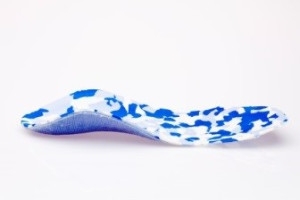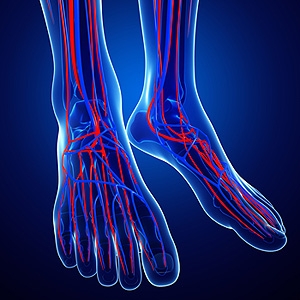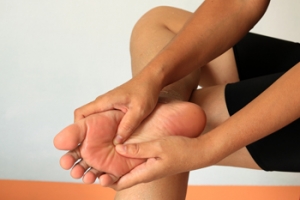Connect With Us
Featured Articles
Super User
How Are Orthotics Made?
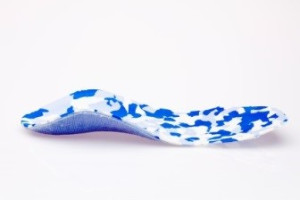 Many patients who experience a variety of foot conditions find it beneficial to wear custom-made orthotics. These types of insoles can provide support, and may be helpful in correcting abnormal walking styles. They are constructed after an impression of the foot is taken using a 3-D laser scan, or a plastic mold. The patient will try them on, and adjustments can be made to produce maximum results. There are several foot conditions that can improve from wearing orthotics, which may include plantar fasciitis, bunions, and rheumatoid arthritis. If you would like additional information about the advantages of wearing orthotics, it is suggested that you schedule a consultation with a podiatrist.
Many patients who experience a variety of foot conditions find it beneficial to wear custom-made orthotics. These types of insoles can provide support, and may be helpful in correcting abnormal walking styles. They are constructed after an impression of the foot is taken using a 3-D laser scan, or a plastic mold. The patient will try them on, and adjustments can be made to produce maximum results. There are several foot conditions that can improve from wearing orthotics, which may include plantar fasciitis, bunions, and rheumatoid arthritis. If you would like additional information about the advantages of wearing orthotics, it is suggested that you schedule a consultation with a podiatrist.
If you are having discomfort in your feet and would like to try orthotics, contact Dr. Thong V. Truong from California. Our doctor can provide the care you need to keep you pain-free and on your feet.
What Are Orthotics?
Orthotics are inserts you can place into your shoes to help with a variety of foot problems such as flat feet or foot pain. Orthotics provide relief and comfort for minor foot and heel pain but can’t correct serious biomechanical problems in your feet.
Over-the-Counter Inserts
Orthotics come in a wide variety of over-the-counter inserts that are used to treat foot pain, heel pain, and minor problems. For example, arch supports can be inserted into your shoes to help correct overarched or flat feet, while gel insoles are often used because they provide comfort and relief from foot and heel pain by alleviating pressure.
Prescription Orthotics
If over-the-counter inserts don’t work for you or if you have a more severe foot concern, it is possible to have your podiatrist prescribe custom orthotics. These high-quality inserts are designed to treat problems such as abnormal motion, plantar fasciitis, and severe forms of heel pain. They can even be used to help patients suffering from diabetes by treating foot ulcers and painful calluses and are usually molded to your feet individually, which allows them to provide full support and comfort.
If you are experiencing minor to severe foot or heel pain, it’s recommended to speak with your podiatrist about the possibilities of using orthotics. A podiatrist can determine which type of orthotic is right for you and allow you to take the first steps towards being pain-free.
If you have any questions please contact our office located in Chico, CA . We offer the newest diagnostic and treatment technologies for all your foot and ankle needs.
Different Types of Running Shoes
 Research has indicated the most common form of running is done on roads. The hard ground may play havoc on the human body, and it is beneficial to wear running shoes that are correct for you. It is helpful to know how your foot strikes the ground. This is easily accomplished by looking at a current pair of running shoes and noticing where the sole is worn. Additionally, having good support in a shoe is important to consider if long distance running is preferred. When there is adequate cushioning in the shoe, it will be easier to run much more comfortably. Many runners have a recovery shoe, and this is worn after running a race, or if an injury to the foot has occurred. If you would like additional information about the different types of running shoes, it is suggested that you speak to a podiatrist who can answer any questions you may have.
Research has indicated the most common form of running is done on roads. The hard ground may play havoc on the human body, and it is beneficial to wear running shoes that are correct for you. It is helpful to know how your foot strikes the ground. This is easily accomplished by looking at a current pair of running shoes and noticing where the sole is worn. Additionally, having good support in a shoe is important to consider if long distance running is preferred. When there is adequate cushioning in the shoe, it will be easier to run much more comfortably. Many runners have a recovery shoe, and this is worn after running a race, or if an injury to the foot has occurred. If you would like additional information about the different types of running shoes, it is suggested that you speak to a podiatrist who can answer any questions you may have.
If you are a runner, wearing the right running shoe is essential. For more information, contact Dr. Thong V. Truong from California. Our doctor can provide the care you need to keep you pain-free and on your feet.
Choosing the Right Running Shoe for Your Foot Type
To increase performance and avoid the risk of injury, it is important to choose the right running shoe based on your foot type. The general design of running shoes revolves around pronation, which is how the ankle rolls from outside to inside when the foot strikes the ground.
- Neutral runners are able to choose from a wide variety of shoes, including minimalist shoes or even going barefoot.
- Runners who overpronate, or experience an over-abundance of ankle rolling, should choose shoes that provide extra motion control and stability.
- Runners who underpronate, or supinate, have feet that have high arches and lack flexibility, preventing shock absorption. They require shoes with more flexibility and cushion.
If you have any questions please feel free to contact our office located in Chico, CA . We offer the newest diagnostic and treatment technologies for all your foot and ankle needs.
Foot Surgery May Help Arthritis in the Feet
 Arthritis in the feet may cause pain and discomfort, and having surgery performed may be an option for relief. Broken bones may occur as a result of bones that are weak, and surgery may be necessary to reposition the bone so the healing process can take place. A procedure that is referred to as arthroscopic debridement may aid in removing inflamed tissue on the affected joints. Additionally, some patients may benefit from joint fusion. This consists of removing a portion of the bone where it connects to the joint, and replacing it with pins. This may alleviate pain and provide additional support for maintaining strong bones. If you are experiencing pain or arthritis in your foot, it is suggested that you consult with a podiatrist who can recommend the type of foot surgery that is right for you.
Arthritis in the feet may cause pain and discomfort, and having surgery performed may be an option for relief. Broken bones may occur as a result of bones that are weak, and surgery may be necessary to reposition the bone so the healing process can take place. A procedure that is referred to as arthroscopic debridement may aid in removing inflamed tissue on the affected joints. Additionally, some patients may benefit from joint fusion. This consists of removing a portion of the bone where it connects to the joint, and replacing it with pins. This may alleviate pain and provide additional support for maintaining strong bones. If you are experiencing pain or arthritis in your foot, it is suggested that you consult with a podiatrist who can recommend the type of foot surgery that is right for you.
Foot surgery is sometimes necessary to treat a foot ailment. To learn more, contact Dr. Thong V. Truong of California. Our doctor will assist you with all of your foot and ankle needs.
When Is Surgery Necessary?
Foot and ankle surgery is generally reserved for cases in which less invasive, conservative procedures have failed to alleviate the problem. Some of the cases in which surgery may be necessary include:
- Removing foot deformities like bunions and bone spurs
- Severe arthritis that has caused bone issues
- Cosmetic reconstruction
What Types of Surgery Are There?
The type of surgery you receive will depend on the nature of the problem you have. Some of the possible surgeries include:
- Bunionectomy for painful bunions
- Surgical fusion for realignment of bones
- Neuropathy decompression surgery to treat nerve damage
Benefits of Surgery
Although surgery is usually a last resort, it can provide more complete pain relief compared to non-surgical methods and may allow you to finally resume full activity.
Surgical techniques have also become increasingly sophisticated. Techniques like endoscopic surgery allow for smaller incisions and faster recovery times.
If you have any questions please feel free to contact our office located in Chico, CA . We offer the newest diagnostic and treatment technologies for all your foot and ankle needs.
Many Types of Foot Surgery
 Many patients have had their various foot conditions successfully treated, but for some, foot surgery may be necessary as a possible option for relief. There are several types of foot issues that can benefit from having foot surgery performed, and these may include bunions, hammertoes, and arthritis. The surgery that may help to correct bunions is referred to as a bunionectomy. The benefits of having this type of surgery performed may include wearing shoes that are closed, and performing daily activities with ease. Arthritis may be helped by having fusion surgery performed, and this may help to join the bones of the foot together which may eliminate painful rubbing. Hammertoe can be helped by removing bones, tendons, or joints which may help to straighten out the toe. If the plantar fascia is inflamed which may lead to plantar fasciitis, heel surgery may be a viable option to consider. If you would like additional information about foot surgery, please consult with a podiatrist who can answer any questions you may have.
Many patients have had their various foot conditions successfully treated, but for some, foot surgery may be necessary as a possible option for relief. There are several types of foot issues that can benefit from having foot surgery performed, and these may include bunions, hammertoes, and arthritis. The surgery that may help to correct bunions is referred to as a bunionectomy. The benefits of having this type of surgery performed may include wearing shoes that are closed, and performing daily activities with ease. Arthritis may be helped by having fusion surgery performed, and this may help to join the bones of the foot together which may eliminate painful rubbing. Hammertoe can be helped by removing bones, tendons, or joints which may help to straighten out the toe. If the plantar fascia is inflamed which may lead to plantar fasciitis, heel surgery may be a viable option to consider. If you would like additional information about foot surgery, please consult with a podiatrist who can answer any questions you may have.
Foot surgery is sometimes necessary to treat a foot ailment. To learn more, contact Dr. Thong V. Truong of California. Our doctor will assist you with all of your foot and ankle needs.
When Is Surgery Necessary?
Foot and ankle surgery is generally reserved for cases in which less invasive, conservative procedures have failed to alleviate the problem. Some of the cases in which surgery may be necessary include:
- Removing foot deformities like bunions and bone spurs
- Severe arthritis that has caused bone issues
- Cosmetic reconstruction
What Types of Surgery Are There?
The type of surgery you receive will depend on the nature of the problem you have. Some of the possible surgeries include:
- Bunionectomy for painful bunions
- Surgical fusion for realignment of bones
- Neuropathy decompression surgery to treat nerve damage
Benefits of Surgery
Although surgery is usually a last resort, it can provide more complete pain relief compared to non-surgical methods and may allow you to finally resume full activity.
Surgical techniques have also become increasingly sophisticated. Techniques like endoscopic surgery allow for smaller incisions and faster recovery times.
If you have any questions please feel free to contact our office located in Chico, CA . We offer the newest diagnostic and treatment technologies for all your foot and ankle needs.
How a Broken Toe Is Diagnosed
 There are several ways a broken toe can happen. These may include a sudden fracture by dropping a heavy object on your toes, stubbing your toe, or having a stress fracture gradually occur. Noticeable symptoms of a broken toe may include severe pain, discomfort, swelling, and many patients may see signs of bruising beginning to appear. In severe fractures, the toe may look crooked, and the ability to walk may be hindered. Once a proper diagnosis confirms the toe is broken, which typically happens when an X-ray is performed, the correct course of treatment can commence. It may be beneficial to elevate your foot, and this may aid in reducing a portion of the swelling, in addition to wearing a shoe with a stiff sole that can provide maximum support. If you have broken your toe, it is suggested that you speak to a podiatrist who can properly guide you through the healing process.
There are several ways a broken toe can happen. These may include a sudden fracture by dropping a heavy object on your toes, stubbing your toe, or having a stress fracture gradually occur. Noticeable symptoms of a broken toe may include severe pain, discomfort, swelling, and many patients may see signs of bruising beginning to appear. In severe fractures, the toe may look crooked, and the ability to walk may be hindered. Once a proper diagnosis confirms the toe is broken, which typically happens when an X-ray is performed, the correct course of treatment can commence. It may be beneficial to elevate your foot, and this may aid in reducing a portion of the swelling, in addition to wearing a shoe with a stiff sole that can provide maximum support. If you have broken your toe, it is suggested that you speak to a podiatrist who can properly guide you through the healing process.
A broken toe can be very painful and lead to complications if not properly fixed. If you have any concerns about your feet, contact Dr. Thong V. Truong from California. Our doctor will treat your foot and ankle needs.
What to Know About a Broken Toe
Although most people try to avoid foot trauma such as banging, stubbing, or dropping heavy objects on their feet, the unfortunate fact is that it is a common occurrence. Given the fact that toes are positioned in front of the feet, they typically sustain the brunt of such trauma. When trauma occurs to a toe, the result can be a painful break (fracture).
Symptoms of a Broken Toe
- Throbbing pain
- Swelling
- Bruising on the skin and toenail
- The inability to move the toe
- Toe appears crooked or disfigured
- Tingling or numbness in the toe
Generally, it is best to stay off of the injured toe with the affected foot elevated.
Severe toe fractures may be treated with a splint, cast, and in some cases, minor surgery. Due to its position and the pressure it endures with daily activity, future complications can occur if the big toe is not properly treated.
If you have any questions please feel free to contact our office located in Chico, CA . We offer the newest diagnostic and treatment technologies for all your foot and ankle needs.
Symptoms of Poor Circulation
 There are many symptoms that are associated with the condition that is referred to as poor circulation. These uncomfortable signs may include a tingling sensation in the feet, painful cramps in the joints and muscles, in addition to the feet and ankles becoming swollen. Additionally, some patients experience digestive problems or changes in skin color. These symptoms may be indicative of serious medical conditions that may be present in the body, including possible heart issues or memory loss. One of the most common reasons for poor circulation developing is known as atherosclerosis which consists of excess plaque that builds up in the arteries, and this may possibly slow down blood flow movement in the body. Research has shown that being obese and cigarette smoking may increase the chances of developing poor circulation. If you notice your feet are cold and numb most of the time, it is advised to seek the counsel of a podiatrist as quickly as possible who can determine the cause and begin the correct treatment.
There are many symptoms that are associated with the condition that is referred to as poor circulation. These uncomfortable signs may include a tingling sensation in the feet, painful cramps in the joints and muscles, in addition to the feet and ankles becoming swollen. Additionally, some patients experience digestive problems or changes in skin color. These symptoms may be indicative of serious medical conditions that may be present in the body, including possible heart issues or memory loss. One of the most common reasons for poor circulation developing is known as atherosclerosis which consists of excess plaque that builds up in the arteries, and this may possibly slow down blood flow movement in the body. Research has shown that being obese and cigarette smoking may increase the chances of developing poor circulation. If you notice your feet are cold and numb most of the time, it is advised to seek the counsel of a podiatrist as quickly as possible who can determine the cause and begin the correct treatment.
While poor circulation itself isn’t a condition; it is a symptom of another underlying health condition you may have. If you have any concerns with poor circulation in your feet contact Dr. Thong V. Truong of California. Our doctor will treat your foot and ankle needs.
Poor Circulation in the Feet
Peripheral artery disease (PAD) can potentially lead to poor circulation in the lower extremities. PAD is a condition that causes the blood vessels and arteries to narrow. In a linked condition called atherosclerosis, the arteries stiffen up due to a buildup of plaque in the arteries and blood vessels. These two conditions can cause a decrease in the amount of blood that flows to your extremities, therefore resulting in pain.
Symptoms
Some of the most common symptoms of poor circulation are:
- Numbness
- Tingling
- Throbbing or stinging pain in limbs
- Pain
- Muscle Cramps
Treatment for poor circulation often depends on the underlying condition that causes it. Methods for treatment may include insulin for diabetes, special exercise programs, surgery for varicose veins, or compression socks for swollen legs.
As always, see a podiatrist as he or she will assist in finding a regimen that suits you. A podiatrist can also prescribe you any needed medication.
If you have any questions, please feel free to contact our office located in Chico, CA . We offer the newest diagnostic and treatment technologies for all your foot care needs.
Causes Symptoms and Treatment for Poor Circulation in the Feet
The purpose of the body’s circulation system is to transport blood, oxygen, and nutrients throughout the body. A reduction of blood to a specific part of the body may cause one to experience symptoms of poor circulation. The most common causes of poor circulation in the feet are obesity, diabetes, and heart conditions such as peripheral artery disease (PAD). Common symptoms of poor circulation include tingling, numbness, throbbing, pain and muscle cramps.
Peripheral artery disease is a common cause of poor circulation in the legs. Symptoms of PAD are cramping, pain or tiredness in the leg or hip muscles while walking or climbing stairs. This pain tends to go away with rest and starts back up when you begin to walk. It is a condition that causes the blood vessels and arteries to become narrow. Although PAD is more common in adults over the age of 50, it may also occur in younger people. A similar condition called atherosclerosis causes arteries to stiffen up due to a buildup of plaque in the arteries and blood vessels.
Blood clots are also a common cause of poor circulation in the feet. Clots may obstruct blood vessels and if they occur in the legs, they may eventually lead to pain and discoloration. This occurrence is commonly known as deep vein thrombosis (DVT) and it may travel to the lungs. Varicose veins are another condition that may lead to poor circulation, and it is caused by incompetence of the valves in the veins. Women who are overweight are prone to developing this condition. Lastly, diabetes, which is correlated with poor blood sugar metabolism may lead to chronic poor circulation. Those with diabetes often suffer from cramping in the legs, calves, thighs and buttocks.
If you are looking for ways to avoid poor circulation there are some tips you can follow. One tip is to avoid sitting for too long. If you plan to sit down for a long period of time, you should try standing up occasionally, to improve your circulation. Another great way to avoid poor circulation is to exercise. Exercise is an excellent way to pump the heart and increase blood flow. Those who suffer from poor circulation should also avoid smoking, reduce their salt intake, and try to lose weight.
If you are experiencing symptoms from poor circulation in your feet, you should consult with your podiatrist to determine the best method for treatment for you. He or she may prescribe medication in addition to recommending specific lifestyle changes to improve your circulation.
Is Foot Therapy Effective?
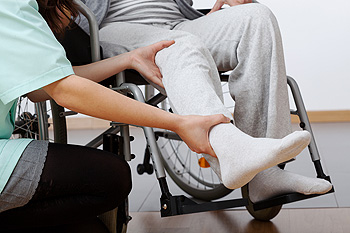 Many people have experienced foot and ankle injuries and may be familiar with physical therapy as a form of positive foot therapy. It may contribute in providing the desired relief, which may be needed from uncomfortable foot conditions that may include plantar fasciitis or foot and ankle fractures. This type of therapy may be conducive in restoring joint mobility, much needed muscle strength, in addition to improvements in walking. These types of injuries may originate from overuse of the muscles and tendons in the feet and ankles. Additionally, foot therapy may be useful in recovering from foot or ankle surgery. If you have endured a serious injury to your foot, ankle, or surrounding areas, it is advised to seek the counsel of a podiatrist who can recommend the best form of therapy for you.
Many people have experienced foot and ankle injuries and may be familiar with physical therapy as a form of positive foot therapy. It may contribute in providing the desired relief, which may be needed from uncomfortable foot conditions that may include plantar fasciitis or foot and ankle fractures. This type of therapy may be conducive in restoring joint mobility, much needed muscle strength, in addition to improvements in walking. These types of injuries may originate from overuse of the muscles and tendons in the feet and ankles. Additionally, foot therapy may be useful in recovering from foot or ankle surgery. If you have endured a serious injury to your foot, ankle, or surrounding areas, it is advised to seek the counsel of a podiatrist who can recommend the best form of therapy for you.
Foot therapy is often necessary for those recovering from either foot deformities or foot injuries. If you have concerns regarding therapy, Dr. Thong V. Truong of California. Our doctor can provide the care you need to keep you pain-free and on your feet.
Most Common Injuries
People who are active or athletes are prone to a variety of injuries. Therefore, it is often important to take part in physical therapy in order to quickly get back on the right track.
What to Do When Injured
Physical Therapy – This specialized treatment will focus on the affected area, speeding up recovery and the overall healing process. It is a proven method that has helped millions of people return from any injury.
During physical therapy you will undergo regimented training to get back into full form. Training is often very difficult, especially at first when the foot feels weak. Physical therapy often involves:
Basic stretching and twisting exercises – getting the feet’s mobility and flexibility up.
Massaging – the therapist will massage the injured area in order to activate the muscles and relax them.
Strengthening Exercises – this allows the muscles in the affected area to regain their full strength, a vital step towards full recovery.
If you have any questions please feel free to contact our office located in Chico, CA . We offer the newest diagnostic tools and technology to treat your foot and ankle needs.
Foot Therapy for Sports Injuries
Foot Therapy for Sports Injuries
Athletes are used to engaging in high-intensity workouts. Consequently, athletes are at an increased risk for enduring foot or ankle injuries. The most common way to treat these types of injuries is the RICE method (Rest, Ice, Compression, and Elevation). However, braces and casts may be required in some cases. If you are suffering from any of these injuries, it is best that you seek help from your podiatrist right away.
Achilles Tendinitis
Achilles tendinitis is a type of overuse injury of the Achilles tendon, which is the tendon connecting the calf muscles to the heel. This type of injury commonly occurs in runners who increase the intensity of their workouts. Symptoms for this condition start off as a mild ache in the back leg or above the heel. Some people experience tenderness around the area in the morning, however this feeling tends to improve over time. If you suspect you have Achilles tendinitis, you doctor may order an x-ray to show whether your Achilles tendon has calcified. Common treatment options for this condition include rest, ice, exercise, and non-steroidal anti-inflammatory medication.
Plantar Fasciitis
Plantar Fasciitis is a condition that is commonly found in women. It is a painful condition that occurs when the bands of tissue that connect the heel to the toes become inflamed. Symptoms for plantar fasciitis are heel pain that worsens in the morning and improves throughout the day with activity. Your podiatrist will diagnose plantar fasciitis by checking for tender areas on your foot. In rare cases, an x-ray may be required for a more thorough examination. There are various treatment options that may be used to help someone with this ailment. Depending on the specific case, some of these options include: physical therapy, shockwave therapy, and in rare cases, surgery.
Stress Fractures
Stress fractures are tiny cracks in the bone that occur due to repetitive force. These fractures are typically the result of overuse injuries such as repeatedly running and jumping. Symptoms of a stress fracture include pain when exercising, tenderness, and mild swelling. To diagnose a stress fracture, your doctor will likely ask you a series of questions about your overall health and the activities you are involved in. Next, an x-ray will likely be performed to check for the fracture. In some cases, fractures don’t appear on x-rays until weeks afterward. In these cases, an MRI or a bone scan may be required. Typical stress fractures may be treated by resting the area and taking a break from highly intense activities.
Ankle Sprain
Ankle sprains occur when the ligaments that support the ankle are stretched far beyond their limits. These injuries occur when you roll, twist, or turn your ankle in an awkward way. Ligaments are essential in helping us move around because they are responsible for stabilizing the joints. Usually, sprained ankles occur due to ligaments on the outer part of the ankle becoming stretched. Symptoms of ankle sprains are swelling, bruising, instability of the ankle, and restricted range of motion. Normally, when people sprain their ankle, they will hear a popping sound during the injury. Depending on the severity, ankle sprains are graded based on how much damage has occurred to the ligaments. Grade 1 is mild, grade 2 is moderate, and grade 3 is severe.
Possible Causes of Morton’s Neuroma
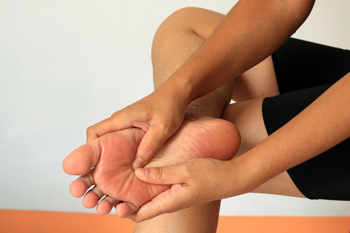 Morton’s neuroma is the medical term described as an uncomfortable foot condition that is typically located on the bottom of the foot under the third and fourth toes. If the nerve that lies there becomes irritated and swollen, you may experience symptoms that include a tingling or burning sensation, or pain inside the ball of the foot. These symptoms may develop over time and this may depend on what type of shoes are worn or the activities that are performed. Common causes for this condition to develop may come from shoes that do not have adequate room for the toes to move about in, or shoes that exert excess pressure on the ball of the foot. It’s suggested to consult with a podiatrist if you feel you have developed this ailment to discuss proper treatment options.
Morton’s neuroma is the medical term described as an uncomfortable foot condition that is typically located on the bottom of the foot under the third and fourth toes. If the nerve that lies there becomes irritated and swollen, you may experience symptoms that include a tingling or burning sensation, or pain inside the ball of the foot. These symptoms may develop over time and this may depend on what type of shoes are worn or the activities that are performed. Common causes for this condition to develop may come from shoes that do not have adequate room for the toes to move about in, or shoes that exert excess pressure on the ball of the foot. It’s suggested to consult with a podiatrist if you feel you have developed this ailment to discuss proper treatment options.
Morton’s neuroma is a very uncomfortable condition to live with. If you think you have Morton’s neuroma, contact Dr. Thong V. Truong of California. Our doctor will attend to all of your foot care needs and answer any of your related questions.
Morton’s Neuroma
Morton's neuroma is a painful foot condition that commonly affects the areas between the second and third or third and fourth toe, although other areas of the foot are also susceptible. Morton’s neuroma is caused by an inflamed nerve in the foot that is being squeezed and aggravated by surrounding bones.
What Increases the Chances of Having Morton’s Neuroma?
- Ill-fitting high heels or shoes that add pressure to the toe or foot
- Jogging, running or any sport that involves constant impact to the foot
- Flat feet, bunions, and any other foot deformities
Morton’s neuroma is a very treatable condition. Orthotics and shoe inserts can often be used to alleviate the pain on the forefront of the feet. In more severe cases, corticosteroids can also be prescribed. In order to figure out the best treatment for your neuroma, it’s recommended to seek the care of a podiatrist who can diagnose your condition and provide different treatment options.
If you have any questions, please feel free to contact our office located in Chico, CA . We offer the newest diagnostic and treatment technologies for all your foot care needs.
